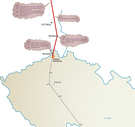JAT Flight 367
 | |
| Occurrence | |
|---|---|
| Date | January 26, 1972 |
| Summary | Bombing |
| Site | Srbská Kamenice, Czechoslovakia |
| Aircraft type | McDonnell Douglas DC-9-32 |
| Operator | JAT Yugoslav Airlines |
| Registration | YU-AHTdisaster |
| Flight origin | |
| Last stopover | |
| Destination | |
| Passengers | 23 |
| Crew | 5 |
| Fatalities | 27 |
| Injuries | 1 |
| Survivors | 1 |
JAT Yugoslav Airlines Flight 367, was a McDonnell Douglas DC-9-32 aircraft (registration YU-AHT) which exploded shortly after overflying NDB Hermsdorf, East Germany while en route from Stockholm to Belgrade on January 26, 1972. The aircraft piloted by captain Ludvig Razdrih broke into two pieces, spun out of control, crashing near the village of Srbská Kamenice in Czechoslovakia (now the Czech Republic). 27 of 28 of those on board were killed upon ground impact; but a crew member, Vesna Vulović, survived.[1]
Cause

On the morning of 27 January 1972 an anonymous man called the newspaper Kvällsposten published in Malmö, Sweden claiming in broken Swedish that he was a Croat and member of Croatian National Resistance, Ustasha terrorist group that also killed SFRY ambassador Vladimir Rolović in Sweden later that year, and claimed responsibility for the bombing.
The crash site was sealed off for 24 hours. Vesna Vulović was at the back of the plane at the time of the explosion and survived the initial explosion. The back part of the plane was torn away from the main fuselage and she fell from 10,160 meters (33,000 feet) before impact with the ground. A food tray pinned her to the back of the plane during her fall, acting as a seat belt, thus preventing her from being sucked out of the plane during de-compression or the ensuing fall. Though she was at the back when the explosion occurred she was said to be found in the middle section of the plane.
Vulović was in a coma for 27 days and was temporarily paralyzed from the waist down, but survived.[2] She continued working for the airline, holding a desk job.
In popular culture
Vesna Vulovic holds the official record in the Guinness Book of Records for the highest fall survived without a parachute.[3] Vesna received the Guinness prize from Paul McCartney, at height of her fame.
Others have survived falls above 1,880 feet. In 1942 a Russian bailed out of his Ilyushinn at 22,000 feet when being attacked by German Messerschmidts. He landed in thick snow and made a speedy recovery. In another war story RAF gunner Nicholas Alkemade fell 18,000 feet and sprained a leg. The branches of pine trees and the snow on the ground saved him.
A major celebrity in SFRY, Vesna Vulović was frequent guest at major Yugoslav TV shows such as Maksovizija by Milovan Ilić Minimaks, up until the 1990s. Vulović attended annual commemorations at the crash site, until they were stopped in 2002. The daughter of the firefighter that saved her bears her name, as well as the local hotel in Czech Republic, near the site of the crash.
The plane crash was a subject of MythBusters. Episode 37, "Escape Slide Parachute (Story of Vesna Vulović)" was devoted to her case[4]. The MythBusters concluded it was possible to survive the fall depending on how the wreckage someone was sitting in landed. Discovery Channel in their programme Against all Odds also profiled Vesna's amazing fall to earth.
Challenges to the official cause
The officially stated cause of the crash was challenged on numerous occasions over the years.
Most recently the discussion about different aspects of the crash was reopened on January 8, 2009 when German news magazine Tagesschau featured an article about the crash proposing a conspiracy theory that the plane was shot only few hundred meters above the ground by the Czechoslovak air force, while attempting forced landing [5]. Czech Civilian Aviation Authority dismissed the claims as media sensationalism, that occurs from time to time, while Vesna Vulović referred to the claims that the plane attempted forced landing or descended to such low altitude as a "nebulous nonsense"[6].
See also
References
External links
- Airliners.Net: Picture of YU-AHT
- PlaneCrashInfo.Com: Entry on Flight 367
- Criminal Occurrence description at the Aviation Safety Network
- JAT 367 Memorial
- Photos of radar screen at ATC Cottbus (East Germany)
